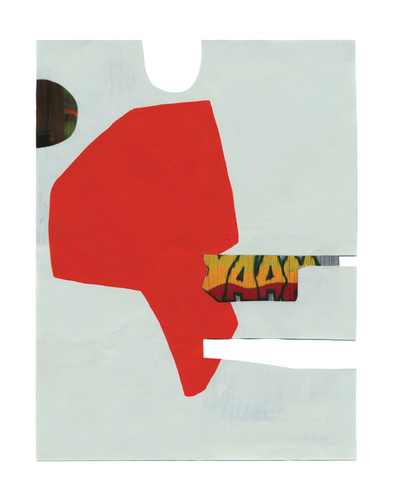The Physicality of Color
Nancy Murphy Spicer, Biking In Berlin, 12, 2010, flashe, gouache collage on guidebook page, 8¼ x 5¾”. Photo: David J. Murray. Courtesy of Carroll and Sons, Boston, MA, and the artist.
Color’s essence tantalizes and eludes. It’s both material substance and optical phenomenon, surface and insubstantial light. The Physicality of Color at the Museum of Art, UNH invites viewers to experience color as a palpable presence with physical dimensionality as well as affective force.
The Physicality of Color surveys work from 13 artists using color as the subject or subtext of their work, often in tangible manifestations. Media represented include installation, sculpture, collage, fabric, painting, video and photography.
The exuberance of color takes physical form in Catherine Evans’s Thistle, in which naked trees outside the gallery sport thick fringes of hot-pink zip-ties. Repurposing the industrial to re-beautify the natural, the arboreal tutus of Thistle playfully reestablish the physical presence of the grayed-out winter landscape itself.
Light assumes palpable presence in Lynn Richardson’s 10-piece hanging installation An Alchemist’s Garden. Richardson’s baroque convolutions of luminous spring green and pale yellow resin suggest monstrous chandeliers, acanthus-like plant forms, a kind of barbed Victoriana summoning the tension between the industrial and the natural. In Keira Kotler’s looped video Crimson, fronds of saturated color sway and churn in silence, suggesting an out-of-focus artery, foliage or fire. Display mirrors complement the metallic glazes of Paul McMullan’s sculptural figures, combining fragments of kitsch figurines in amusing and disturbing ways (at least two literally deface a fairytale girl with a grotesque mask). The result is whimsical, charming and suggestive.
In Nancy Murphy Spicer’s series Biking in Berlin, small abstract collages combine geometric shapes created by mapping her bicycle routes through the city. Laura Moriarty’s geologic sculptural paintings consist of pigmented beeswax layered like mineral cross-sections of geologic and human time.
Masako Kamiya assembles paintings from tiny towers or stalagmites of gouache pigment built up drop by drop. A forest of pointillistic dots in pastel green, pink, violet and lavender, Atlas of Spring, is at once sculptural and visual: Is it an optical experience or a physical one? Similarly, though Bill Thompson considers himself a painter, he hand-carves minimalist abstract sculptures from blocks of polyurethane and spray-coats them with 20 layers of custom-mixed automotive color and urethane. The point is inextricable form and color, constantly shifting with the viewer’s perspective.

